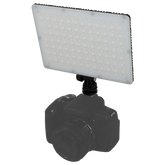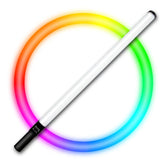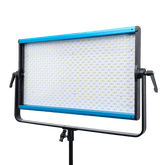Hard and soft light: Thats the difference
Hard and soft light: how the hardness of the light influences the effect of the picture
Light plays a crucial role in photography and video photography. The light changes constantly and varies depending on the time of day and season, geographical location, air pollution and weather. There are mainly differences with regard to the color temperature and the direction of light. In order to achieve successful recordings when taking photos or films, you should make sure that you use the lighting mood in a targeted manner. When recording outdoors, this means precisely planning the sunrise, the weather, the course of the sun and the location of the location. In studio recordings, on the other hand, it is important to work with the right light sources in order to ensure the best possible lighting mood in the picture.
When illuminating a subject, a distinction is made in photography and videography between hard light and soft light. It is important for you to know the differences so that you can consciously work with the hard or soft light. Because: Depending on how hard the light is, very different effects are created in the shot. These can either underline your idea for a shot or - if the lighting is not correctly observed - counteract your actual goal. For this reason, you will find out everything about hard light and soft light, the effect of the two types of light and how you can create the respective light in a targeted manner.
The important things first
- The right lighting plays a decisive role in photo and video recordings and has a considerable influence on the overall effect.
- In photography and filmmaking, a distinction is made between hard light and soft light.
- Hard light creates strong contrasts, noticeable highlights at reflective points and hard shadows.
- Soft light makes a subject appear low in contrast and is characterized by few, soft shadows and natural delicacy, which is why it is often the method of choice for portraits.
Hard light

Hard light is usually not that popular in video and photo shoots because it casts harsh shadows. The shadow edges are sharply delimited with clear edges. Especially in the midday sun there are hard shadows when taking photos of buildings and people, which can interfere with the image effect. Sometimes, however, hard light is also created deliberately when a certain light setting is to be achieved.
What is hard light?
The smaller the light source that illuminates a subject, the more contrasting is the picture - this is called hard light. If there is only a point light source, extremely hard light is produced. There are noticeable shadows and contrasts, so that practically no details can be recognized. Shiny motifs show strong highlights without drawing, where the light source is reflected directly. With certain motifs, hard light can underline the desired message. It ensures that the colors get a high level of saturation and look very brilliant. However, portraits with hard light are seldom successful: Dark eye sockets and long nasal shadows are created.
How do you create hard light?
Hard light can be generated by small to point shaped light sources. Not only does the absolute area of the light source play an important role, but also the distance between the illuminated subject and the light source. This is why the sun, with its enormous diameter of 1,400,000 kilometers, can also be viewed as a point-like source of illumination, because the distance to the earth is so great. When exposed to direct sunlight, the sun also generates hard light.
In addition, hard light can be generated in a targeted manner using artificial lighting. You don't have to put in a lot of effort for this, because hard light usually arises by itself. Usually there is only one light source that shines point by point on the object from one or more directions. In particular, light sources with small reflectors - such as integrated or external flash units - provide hard light. The result is a plastic effect that is usually not desired. The effect is softened by the front light, because the extreme shadow cast disappears. If the subject is illuminated from the side, a strong shadow is also created in hard light. The illuminated object can appear more three-dimensional. In this way, when taking portraits, the person being recorded has a more striking effect. Light shapers such as a spot or tube can also be used to generate hard light in a targeted manner.
Soft light

In contrast to hard light, soft light casts almost no or only very soft shadows. This applies, for example, to sunlight on cloudy or rainy days. The light does not reach the motif selectively from one direction, but rather diffusely. The resulting shadows have blurred and soft edges.
What is soft light?
Soft light is created automatically outdoors when the sky is cloudy. The sun as a light source then has an enormous radiating surface and the light is distributed very evenly. Contrasts are only sparse and there are no sharp shadows. This can be rather inconvenient for landscape shots and give the impression of monotony. For portraits, on the other hand, soft light is very popular because it makes striking faces appear more even and unevenness of the skin into the background.
How do you create soft light?
If you want to work outdoors with soft light, it is best to choose a very cloudy day. Soft light can also arise in fog and sunshine, provided that the position of the sun is appropriate. This creates soft images - similar to the use of a diffusion wall.
In the studio, you create soft light by deflecting the light source. Flash light, for example, must not flash directly on the subject, but on a screen or a neutral wall. The reflection enlarges the surface of the light and makes it appear softer overall. An alternative are soft boxes or octaboxes, which also lead to a larger radiating surface and thus to softer light. You can also work with translucent umbrellas in the home studio. The large, white and translucent umbrellas are placed between the motif and the flash, which gives them an effect similar to a softbox.
Soft light in the studio can be better controlled by modeling it from the outset not with a point light source, but with surface lights. You can also create targeted soft light with our Luna T Softlight. When generating soft light with surface lights, it is important that you pay attention to the distance to the subject. The closer the luminaire is to the object, the softer the light appears. You are welcome to vary this here to try out different lighting effects.
What is the difference between hard and soft light?
Hard light and soft light differ mainly in the following aspects:
- Contrast in the picture
- Casting of shadows
If you work with hard light, strong contrasts arise. Soft light, on the other hand, makes your picture appear low in contrast. The shadow cast is very distinctive and pronounced in hard light. The edges of the shadow are sharply defined and angular. It's different in soft light: The shadow edges are soft and flowing, hard cast shadows are completely avoided.
Is Hard or Soft Light Better?

The question of whether hard light or soft light is more suitable cannot be answered across the board. It always depends on what you are recording and what image effect you want to achieve. Still lifes, for example, come into their own with soft light. Sometimes landscapes can also be photographed well with soft light, for example to emphasize the delicacy and softness of a sunset by the sea. Soft light is also typically used for portrait photography. Soft light is particularly recommended for a beauty shoot that focuses on the face. This is the best way to reproduce the skin tone and make the model look very natural. Even small bumps in the skin and distinctive facial features can be weakened somewhat with soft light.
However, you don't always have to use soft light for portrait photography. For example, if you want to specifically emphasize a person's hardness or fighting spirit, you can also work with harder light. When photographing or filming landscapes, you are also better off with hard light. The same applies to architectural recordings: the hard light emphasizes the geometric shapes and makes the object stand out better from its surroundings. The structure and the shape of the motif can be shown very well with hard light.
Conclusion: Use hard light and soft light in a targeted manner and underline the desired image effect
Light has many different properties and can - depending on the weather, time of day, season and air pollution - achieve a different lighting effect. In photography and filmmaking, a distinction is therefore made between hard light and soft light. For professional recordings that emphasize the desired target with their image effect, it is important to be able to differentiate between soft and hard light and to know how the light hardness can be influenced. Only then do you have the option of using hard or soft light as a stylistic device in your recordings.
There is no general answer to the question of whether you should work with soft or hard light. The optimal illumination always depends on the subject and the desired image effect. Before starting your project, think carefully about what you want to achieve with your recording and what light hardness you need to achieve your goal. Then you can consciously create hard or soft light and thus either provide hard shadows and high contrasts or smooth transitions and a natural softness in the picture.







